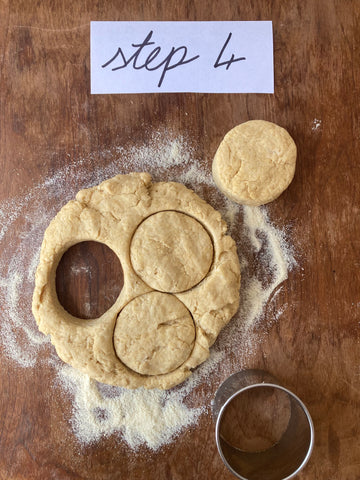Crunchy Sifted Durum Biscuits

Biscuits are a boon to everyone, anytime, anywhere. They call for only a few ingredients and a small amount of time, and always result in delight for both palate and eyes.
Sifted Durum Flour is the protagonist in this recipe, and gives the biscuits a sweet and crunchy profile. There’s nothing wrong with making this your default biscuit recipe, but feel free to use it as a template for endless biscuit exploration.
Recipe and photos by Esther Seha. Esther is a Chicago based activist educator and artistic baker. Find her on Instagram @baker.maker.shaker and at www.cakeandconversation.com .

Ingredients
- 1 cup (150g) Sifted Durum Flour
- 1 cup (100g) Frederick Cake Flour (may substitute All-Purpose or Pastry Flour)
- 2 teaspoons baking powder
- ½ teaspoon salt
- 1 tablespoon sugar
- 3 tablespoons (45g) butter, cold
- ½ cup (70g) yogurt
- ½ cup (125ml) water
- Melted butter for a shiny finish, or flour for a matte finish
Equipment
- 2 ¾ inch round cookie cutter or glass
Instructions

1. Line a large baking sheet with parchment paper or a silicon mat. Preheat oven to 400°F. Combine sifted durum flour, cake flour, sugar, baking powder and salt in a medium bowl. Mix until combined.

2. Cut pieces of butter into the flour mixture and quickly integrate them until all pieces have disappeared uniformly into the flour. Use a pastry blender if you have one. Fingertips will also do the trick.

3. Measure ½ cup of yogurt into a measuring cup. Add enough water to measure 2/3 cup. Using a rubber spatula, incorporate liquid ingredients until they are no longer visible. Then quickly work mixture into a uniform dough with your hands.

4. On a lightly floured surface, pat dough to a thickness of 1 inch and cut out biscuits. Push the cutter or glass straight down so your biscuits will rise nicely. Brush biscuits with melted butter for a shiny finish, or dust with flour for a matte finish. Bake them in the upper half of the oven for 15 to 18 minutes.
Baker’s note:
Biscuits benefit from very cold ingredients and swift hands. Both tricks allow for bits of butter in the dough to stay intact and produce delectable flakiness. Cooling or even freezing ingredients and equipment as well as owning a pastry blender will be helpful in this pursuit.
That being said, doing the right things and owning the right tools shouldn’t stand in the way of anyone enjoying a freshly baked biscuit! Biscuits are ideally suited for experimentation -- from swapping out flours and liquids, to trying out different shapes and techniques. Creativity knows no bounds.
Theme and Variations
Here are a few points of inspiration and adaptation:
- Even though some flours might require a little more liquid, most will make fine biscuits. Feel free to adapt this recipe using All-Purpose, Pastry Flour, or a combination of flours.
- When using flours that don’t contain gluten (e.g buckwheat or corn flour), use a combination of flours (a 1:1 ratio usually works well).
- Yogurt and baking powder can be replaced with buttermilk and ½ teaspoon baking soda.
- If you don't have buttermilk on hand, make it by adding some lemon juice to the milk (wait a few minutes until the mixture curdles).
- The dough can be shaped into a rectangle and cut into triangles or squares.
- It can also be shaped in a round and cut into wedges. Using different sizes and shapes of cookie cutters is a nice adventure.

Posted on February 14 2022
